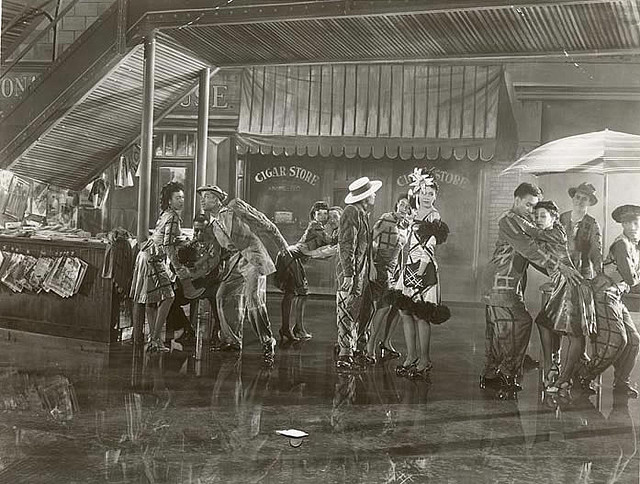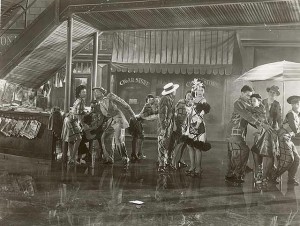Of course, jazz writ large is now an ancient “world” music, having as much in it today of the sound of the kasbah as it always has of New Orleans, Harlem and Chicago. But that great first flowering of jazz that we’re focussing on at the Garreteer had a distinct beginning and a definite end: that end came with the death of Joe “King” Oliver in spring 1938, after which all was swing, then bebop and cool. The great summation of all that courage and beauty came after a pause, and in wartime, and on the big screen, in the form of the 1943 musical Stormy Weather.
There are dissenting voices on Stormy Weather as the great jazz film. After all, Cabin in the Sky went from Broadway stage to film in 1943, arguably treated its black performers with greater respect, and featured Ethel Waters, Duke Ellington and Louis Armstrong, all of whom are absent from Stormy Weather. Alan Freed is said to have sought the advice of black community leaders at each stage of Cabin in the Sky.
But it’s Stormy Weather that above all sets out to tell the story of the black musicians of the Jazz Age. And it’s Stormy Weather that brings together every strand of it. The film is loosely based around the life of its star, Bill “Bojangles” Robinson, who we first meet in the US Army in France in the closing months of the Great War. His early struggles in music (and in romance) stand for the struggles of all black musicians, and lead us from ragtime and blues on through mainstream jazz (in a memorable cameo by Fats Waller, who died shockingly young from pneumonia soon after filming), into the glorious all-out danceband swing of Cab Calloway. Sweet Jesus, Cab Calloway…
Calloway is the towering, alpha showman king of this astonishing movie with its 20 numbers in 90 minutes, and his extended rendition of Jumping Jive is the lead-in to Stormy Weather‘s two other keys: the supremacy of black performers (the Nicholas Brothers’ routine in Jumping Jive was – according to Fred Astaire no less – the greatest of all time, and it’s pointless disagreeing); and black music’s unprecedented spread and influence. It’s another Calloway number that prefaces the Lena Horne/Katherine Dunham title number.
The Horne/Dunham Stormy Weather is impossible to summarize: simply, everything that happened in music in the twentieth century is either reprised there or happens within it for the first and best time. Here is black music finding its way into classic composition and into ballet; here it is creating its own Elsinorean film within a film and taking, improving, the familiarities and flavours of noir in ways the New Romantics could only dream of. Horne’s heartbreak fills the foreground, but beyond it, tossed and beleagured by the storms of life, are the young men in zoot suits, the first and most lastingly influential fashion from music in history. And prefacing it all is Cab Calloway, a stage presence to dwarf Presley, Jagger and all who followed. These tropes – these themes – would all recur again and again in the age of rock, but never all at once, and rarely with such class and poise.
Lena Horne: Stormy Weather
Fats Waller: Ain’t Misbehavin
Cab Calloway and the Nicholas Brothers: Jumping Jive


1 Reply to “Garreteer Film: Stormy Weather (1943)”